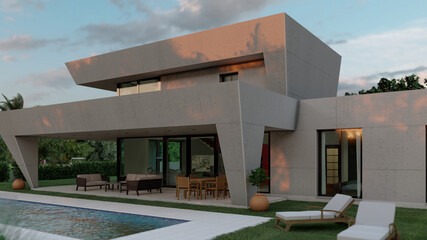Every successful construction project begins with a solid foundation—not just in terms of concrete or steel, but in the groundwork that precedes it. Site preparation is the crucial first phase that determines how well a project will progress and how durable and safe the final structure will be. It involves a systematic process of analyzing, clearing, grading, and stabilizing land to make it suitable for construction.
Without proper preparation, even the most sophisticated building plans can face costly setbacks, safety hazards, and long-term structural issues. Read on or click here at https://lazercompaniesllc.com/ to explore the key elements of site preparation before construction.

Understanding Site Preparation
Site preparation refers to the process of making a piece of land ready for construction. It includes everything from surveying and soil testing to grading, excavation, and utility setup. Each step ensures that the land is stable, level, and compliant with environmental and engineering standards.
Whether the project involves building a single home, a commercial facility, or infrastructure, site preparation provides the necessary groundwork to ensure that construction proceeds safely, efficiently, and according to plan.
The Goals of Site Preparation
Before a construction crew begins building, the land must meet several conditions. The primary goals of site preparation include:
- Creating a stable and level foundation: Proper grading and compaction prevent foundation settling and uneven surfaces.
- Ensuring adequate drainage: A well-prepared site allows water to flow away from structures, preventing flooding or erosion.
- Protecting the environment: Responsible site work minimizes soil disruption, pollution, and damage to natural surroundings.
- Complying with regulations: Site preparation ensures that all local codes, environmental laws, and safety requirements are met.
- Facilitating construction efficiency: A clear and well-prepared site reduces delays, equipment issues, and costly adjustments during construction.
With these objectives in mind, site preparation forms the foundation of a safe and sustainable construction project.
Steps Involved in Site Preparation
Each construction project requires a tailored approach to site preparation, depending on the land type, design plans, and environmental factors. However, the general process follows a series of essential steps.
1. Site Surveying and Assessment
Before any physical work begins, professional surveyors assess the land. They identify boundaries, topography, elevation, and potential obstacles that might affect construction.
This stage often involves:
- Boundary identification: Marking property lines to prevent encroachment.
- Topographic mapping: Determining slopes, elevations, and natural contours.
- Utility mapping: Locating underground utilities like gas, water, and electricity lines.
The survey ensures that design plans align accurately with the land’s physical characteristics.
2. Soil Testing and Geotechnical Analysis
Soil quality is one of the most important factors in determining how a building will perform over time. Engineers conduct soil testing to analyze its composition, density, moisture content, and bearing capacity.
Common soil tests include:
- Compaction tests to assess density and load capacity.
- Moisture tests to evaluate drainage and stability.
- Percolation tests for septic system planning.
The results of these tests influence foundation design, drainage solutions, and material selection.
3. Site Clearing
Once assessments are complete, the next step is clearing the site of obstacles that could interfere with construction. This process involves removing vegetation, rocks, debris, and old structures.
Key tasks may include:
- Tree and stump removal
- Demolition of existing buildings
- Disposal or recycling of waste materials
- Leveling minor surface irregularities
Clearing ensures a clean, obstruction-free workspace and reduces the risk of hazards during construction.
4. Excavation and Grading
Excavation involves removing or redistributing soil to create the desired land contours for foundations, drainage, and utilities. Grading follows, shaping the land to achieve proper slopes and levels.
- Excavation: Contractors dig trenches and holes for foundations, basements, or utility lines.
- Grading: The land is leveled and contoured to promote effective water drainage.
- Backfilling: After structures like foundations are placed, soil is replaced and compacted around them for stability.
Proper grading prevents water accumulation and ensures that the site drains naturally, reducing the risk of erosion or flooding.
5. Compaction and Soil Stabilization
Loose soil can shift or settle over time, leading to uneven foundations and cracks. Compaction compresses the soil to increase its density and load-bearing capacity.
Common methods include using rollers, vibratory plates, or rammers to remove air pockets and achieve uniform soil stability. In cases where the soil is weak, stabilization may involve adding lime, cement, or other materials to strengthen it.
This step is vital for long-term durability and structural integrity.
6. Drainage Planning and Installation
Effective drainage is critical to maintaining a dry, stable construction site. Without it, water can pool, erode soil, and compromise foundations.
Drainage systems are designed to manage surface runoff and groundwater. They may include:
- Stormwater drains and culverts to redirect rainwater
- French drains or perforated pipes for underground water control
- Retention ponds to store excess runoff temporarily
Proper drainage design protects the structure and the surrounding environment from water-related damage.
7. Utility Connection Preparation
Before construction begins, contractors plan for the installation of essential utilities such as water, electricity, gas, and telecommunications. This phase involves digging trenches and conduits to accommodate future connections.
Coordinating utility layouts early helps avoid unnecessary rework and ensures that all systems are installed efficiently once construction begins.
8. Erosion and Sediment Control
During site preparation, exposed soil is vulnerable to erosion caused by wind and rain. To prevent environmental damage, contractors implement erosion control measures such as:
- Installing silt fences and sediment traps
- Using mulch, straw, or geotextiles to protect soil
- Constructing temporary drainage channels
These techniques minimize soil loss, protect nearby water sources, and comply with environmental regulations.
9. Final Site Inspection
After all preparatory work is complete, the site undergoes a final inspection. Engineers verify that the land meets construction requirements, ensuring proper compaction, grading, and drainage. Only after approval can the actual building phase begin.
The Importance of Professional Site Preparation
While site preparation may appear straightforward, it’s a highly technical process that requires expertise, equipment, and coordination. Engaging professional contractors offers several key advantages:
1. Accurate Planning and Execution
Professionals use advanced surveying tools and engineering techniques to ensure precise measurements and leveling, reducing costly errors.
2. Safety Assurance
Trained crews follow safety standards to prevent accidents related to unstable ground, heavy machinery, or underground utilities.
3. Efficiency and Time Savings
Professionals complete work faster and more efficiently, using modern equipment and proven workflows to stay on schedule.
4. Long-Term Stability
Proper soil compaction, drainage, and grading provide a strong foundation that prevents settlement and structural damage over time.
5. Regulatory Compliance
Professional site preparation adheres to building codes, zoning laws, and environmental regulations, preventing legal and financial setbacks.
Environmental Considerations in Site Preparation
Modern construction practices emphasize environmental responsibility. Proper site preparation minimizes ecological disruption while ensuring compliance with environmental regulations.
Key sustainable practices include:
- Erosion control: Reducing sediment runoff and water pollution.
- Recycling materials: Reusing cleared materials like topsoil, gravel, and concrete.
- Dust and noise management: Limiting environmental impact on nearby communities.
- Protecting vegetation: Preserving trees or green buffers where possible.
Sustainable site preparation contributes to long-term land health and aligns with modern green building standards.
Common Challenges in Site Preparation
Despite careful planning, several challenges can arise during site preparation:
- Unexpected soil conditions: Hidden rock layers, groundwater, or unstable soil may require additional engineering solutions.
- Weather disruptions: Heavy rain or extreme heat can delay grading, compaction, and excavation.
- Utility conflicts: Unmarked underground utilities can pose hazards or require redesign.
- Environmental restrictions: Sites near wetlands or protected areas may need special permits or procedures.
Experienced contractors anticipate these challenges and adapt plans accordingly, ensuring that projects remain on track.
Modern Technology in Site Preparation
Technological advancements are transforming the way site preparation is performed, making processes more precise, efficient, and environmentally friendly.
Some key innovations include:
- GPS and Laser Grading: Ensures accurate leveling and reduces material waste.
- 3D Modeling and Mapping: Helps engineers visualize terrain and design optimal grading plans.
- Drones: Used for surveying large areas quickly and accurately.
- Automated Machinery: Improves efficiency and reduces human error during excavation and grading.
- Real-Time Monitoring: Sensors track soil compaction, moisture levels, and progress to ensure quality control.
These technologies enable contractors to complete projects faster while maintaining high standards of accuracy and safety.
The Connection Between Site Preparation and Construction Success
A well-prepared site directly influences the success of the entire construction project. Without proper groundwork, even the best architectural designs can fail. Issues such as uneven settling, poor drainage, or unstable soil can lead to structural damage, costly repairs, and safety hazards.
On the other hand, when site preparation is handled correctly, it creates a seamless transition into the construction phase. Builders can work efficiently on a stable, compliant, and well-organized foundation—saving time, money, and resources.
Site preparation before construction is the unsung hero of every successful project. It’s a complex process that combines engineering, environmental management, and precision planning to ensure that land is safe, stable, and ready for development.
From surveying and soil testing to grading, drainage, and utility planning, each step contributes to long-term safety, durability, and efficiency. Whether for residential or commercial projects, investing in professional site preparation ensures a strong foundation—literally and figuratively—for what’s to come.
In the world of construction, skipping or rushing through site preparation can lead to costly mistakes. Taking the time to do it right sets the stage for lasting success, transforming raw land into a ready canvas for development.

